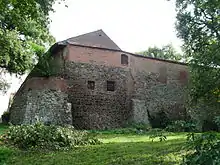Bishopric of Lebus
The Bishopric of Lebus (German: Bistum Lebus; Polish: Diecezja lubuska) was a Roman Catholic diocese of Poland and later an ecclesiastical territory of the Holy Roman Empire. It existed from 1125 until 1598. The diocese encompassed areas on both sides of the Oder River around the town of Lebus/Lubusz later called Lubusz Land.
Prince-Bishopric of Lebus | |||||||||
|---|---|---|---|---|---|---|---|---|---|
| 1248–1555 | |||||||||
 Coat of arms
| |||||||||
.jpg.webp) | |||||||||
| Status | State of the Holy Roman Empire[1] | ||||||||
| Capital | Lebus (Lubusz) Göritz (Górzyca) from 1276 Fürstenwalde from 1373 | ||||||||
| Government | Prince-Bishopric | ||||||||
| Historical era | Middle Ages | ||||||||
• Diocese established | 1125 | ||||||||
| 1248 | |||||||||
• Secularized | 1555 | ||||||||
| 1598 | |||||||||
| |||||||||
| Today part of | |||||||||
History
The diocese was established about 1125 by the Piast Duke Bolesław III Wrymouth of Poland in the westernmost region of Poland in the lands west of Greater Poland settled by pagan Polabian Slavs, in order to counter the eastward expansion of the Holy Roman Empire expedited by Emperor Henry V and the Archbishopric of Magdeburg. Duke Bolesław prompted the construction of St. Adalbert Cathedral in Lubusz, consecrated to the diocesan patron saint Adalbert of Prague, which was later destroyed.[2]


Notes
- Imperial immediacy denied by Brandenburg.
- Walter Stephan, "Das Madonnen-Siegel der VIADRINA und des Bischofs Dietrich von Lebus", in: Gabriel (April 2006), Sammlergilde St. Gabriel e. V. (ed.), cf. online extract Archived May 13, 2010, at the Wayback Machine, retrieved on 18 April 2011.